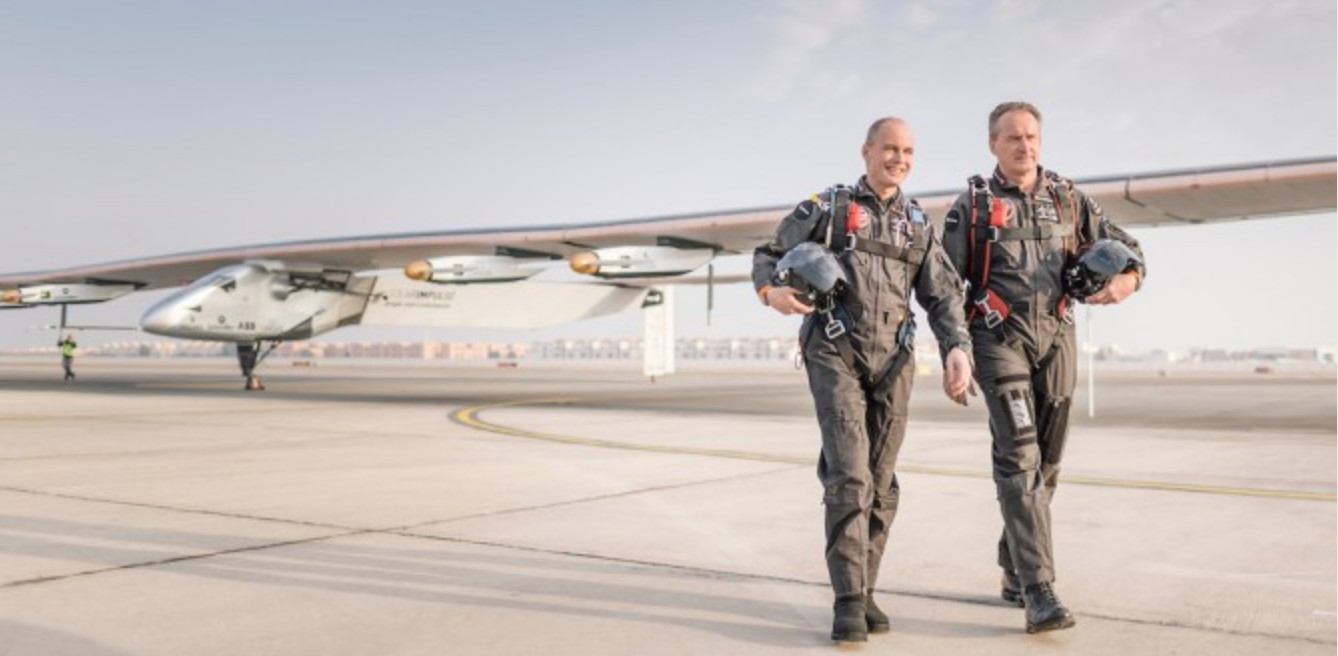“T he eventual goal is to have flown around the world by 2015.”
That is what I wrote in this article back on June 12, 2013 at What’s Your Point? over at First2Board pertaining to the question of whether or not solar energy could one day power commercial airplanes which can operate quietly through the night, pointing out the possibility of an aircraft powered by solar energy to circumnavigate the world sometime this year.
Through a project created in Switzerland called Solar Impulse, its aircraft crossed the United States back in 2013 in segments; and now the team behind the project claims that starting as early as next month, the goal is for the Solar Impulse 2 aircraft to become the first airplane ever to circumnavigate the globe using only the power of the sun to drive its four electric propellers.
The flight around the world will not be a non-stop flight, however, as the flight path will originate in Abu Dhabi to its first destination of Muscat in Oman — two destinations to which I expect to travel over the next few months and report on them here at The Gate — and then across the Arabian Sea to Ahmedabad and Varanasi in India; to Mandalay in Myanmar; to Chongqing and Nanjing in China; then across the Pacific Ocean to Hawaii; then to Phoenix and New York before crossing the Atlantic Ocean with a possible stop somewhere in southern Europe or north Africa before landing at its originating point back in Abu Dhabi.
From #AbuDhabi to #AbuDhabi: the First #RTW #Solar Flight has this route mapped out:http://t.co/MdoCZm4zHP pic.twitter.com/YGdSsxOYdg
— SOLAR IMPULSE (@solarimpulse) January 20, 2015
With improving technology combined with the use of solar power; there is no reason why an aircraft cannot one day circumnavigate the planet non-stop — the Solar Impulse 2 aircraft can theoretically can stay airborne indefinitely by absorbing sunlight using 17,248 solar cells arrayed on expansive wings which span 72 meters or 236 feet — although the speed of the aircraft would likely be significantly slower than that of a commercial airplane…
#DidYouKnow, #Si2 has 17,248 solar cells, powering four 17.4hp electric motors #RTWhttp://t.co/MdoCZm4zHP pic.twitter.com/SKlJCzL4W2
— SOLAR IMPULSE (@solarimpulse) January 20, 2015
…and the primary purpose of the stopovers is because there is currently only one seat for one pilot aboard the Solar Impulse 2 aircraft; and to subject a person to sit in the cramped quarters of an unpressurized cockpit for an excruciatingly long period of time on a non-stop flight would simply be cruel and potentially dangerous. Where would the 2.4 kilograms of food and 2.5 liters of water per day be stored; and what about the accumulation of all of that…er…human waste — not to mention no way of moving freely about the cabin?
#Si2 is a single-seater #airplane, for one pilot to live in for flights of 120 hours!http://t.co/MdoCZm4zHP pic.twitter.com/0rv0BOrKdp
— SOLAR IMPULSE (@solarimpulse) January 20, 2015
Passengers already currently complain about being in an airplane for 18 straight hours — even with those “amenities.” Could you imagine a flight with a possible duration of 120 straight hours, for example?
#Flight12 will complete the First #RTW Solar Flight by landing back in #AbuDhabi http://t.co/MdoCZm4zHP pic.twitter.com/DW06DfNzvG
— SOLAR IMPULSE (@solarimpulse) January 20, 2015
I would say that possible implementation of solar energy as a main power source for commercial aircraft is certainly still years away at this point. There is a lot which needs to be done before that day can ever happen. Besides, there would be laws which would prohibit pilots and other members of the flight crew from working too many hours — unless at least two complete crews are aboard the aircraft, meaning more members of the flight crew and fewer passengers — so marathon flight segments will probably never happen anyway.
Still, there is no reason why we cannot at least dream of the potential power of solar energy pertaining to flight — even if only initially as a supplemental power source at a minimum, helping airlines operate their aircraft more efficiently by potentially using less jet fuel. Solar power is a clean energy source — not counting the manufacturing of materials needed to implement solar power, of course — which is abundant and quiet to use.
If you consider viewing the technology of solar energy helping to power aircraft for at least short-haul flights to potentially fill the voids of transportation which may not be able to be fulfilled by the technology known as the evacuated tube transport system which is supposed to transport people from New York to Beijing in approximately two hours, then this idea could have a place in the future of travel.
I just have one question, though: if fuel surcharges lose credibility with low fuel prices and invite government intervention, what are the odds that airlines will still charge fuel surcharges — or carrier-imposed surcharges, to be more “politically correct” — on aircraft powered by free solar energy?
All photographs and “tweets” courtesy of Solar Impulse.
